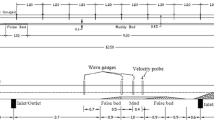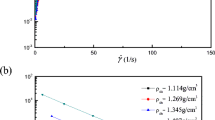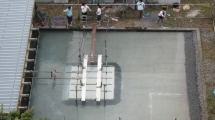Abstract
Although the different aspects of wave-mud interaction have been studied by many researchers, few studies have been conducted on the effect of solitary wave on the particle velocities formed in the layers of cohesive sediments. The main objective of the present study is to investigate different features of the mud mechanical responses to the solitary wave loadings. This paper describes a comprehensive study of solitary wave-mud interaction by means of sets of laboratory tests, in which time series of the velocity in the water and mud layers, as well as free-surface evolutions, were measured. Wave damping and several aspects of the mechanical response of the mud layer to solitary wave loadings, e.g. mud particle velocities, the ratio between positive and negative peak velocities, time shift between peak velocities in the mud and water layer and the mud movement period, were studied through nondimensional parameters. It was shown that, at higher values of the mud water content ratio, the time shifts between the peak velocities in the mud and water layers decrease, whereas the mud movement period and the ratio of the positive to the negative peaks increase. Similar trends were observed as the height of the solitary wave was increased. A viscous analytical two-layered model has been developed. Comparing to the measurements, the present model and the model of Liu and Chan (J Fluid Mech 579:467–480, 2007) presented a similar behaviour for simulating the mechanical response of mud under the action of a solitary wave and both models performed better than the model of Jiang and Zhao (J Waterw Port Coast Ocean Eng 115:345–362, 1989).

















Similar content being viewed by others
References
Beyramzade M, Siadatmousavi SM (2018) Implementation of viscoelastic mud-induced energy attenuation in the third-generation wave model, SWAN. Ocean Dyn 68(1):47–63
Chan IC, Liu PLF (2009) Responses of Bingham-plastic muddy seabed to a surface solitary wave. J Fluid Mech 618(1981):155–180
Dalrymple RA, Liu PL (1978) Waves over soft muds: a two-layer fluid model. J Phys Oceanogr 8(6):1121–1131
Gade HG (1957) Effects of a nonrigid, impermeable bottom on plane surface waves in shallow water. PhD Thesis, Texas A&M University, USA
Hammack JL (1972) Tsunamis—a model of their generation and propagation. Rep. Kh-R-28, W. M. Keck Laboratory of Hydraulics and Water Resources, California Institute of Technology, California
Hsu WY, Hwung HH, Hsu TJ, Torres-Freyermuth A, Yang RY (2013) An experimental and numerical investigation on wave-mud interactions. J Geophys Res Oceans 118(3):1126–1141
Huang CJ, Shen ML, Chang HH (2008) Propagation of a solitary wave over rigid porous beds. Ocean Eng 35(11):1194–1202
Jiang L, Zhao Z (1989) Viscous damping of solitary waves over fluid-mud seabeds. J Waterw Port Coast Ocean Eng 115(3):345–362
Kaihatu JM, Tahvildari N (2012) The combined effect of wave–current interaction and mud-induced damping on nonlinear wave evolution. Ocean Model 41:22–34
Kaihatu JM, Sheremet A, Holland KT (2007) A model for the propagation of nonlinear surface waves over viscous muds. J Coast Eng 54:752–764
Lakshmanan M (2007) Integrable nonlinear wave equations and possible connections to tsunami dynamics. In: Kundu A (ed) Tsunami and nonlinear waves. Springer, Berlin, pp 31–49
Li Y, Raichlen F (2003) Energy balance model for breaking solitary wave run-up. J. Waterway, Port. Coast Ocean Eng 47:47–59
Liu PLF, Chan IC (2007) On long-wave propagation over a fluid-mud seabed. J Fluid Mech 579:467–480
Madsen PA, Fuhrman DR, Schäffer HA (2008) On the solitary wave paradigm for tsunamis. J Geophys Res Oceans 113(C12)
Ng CO (2000) Water waves over a muddy bed: a two-layer Stokes’ boundary layer model. Journal of Coastal Engineering 40:221–242
Ng CO, Zhang X (2007) Mass transport in water waves over a thin layer of soft viscoelastic mud. J Fluid Mech 573:105–130
Park YS (2009) Seabed dynamics and breaking waves. PhD Thesis, Cornell University, United States
Park YS, Liu PL-F, Clark SJ (2008) Viscous flows in a muddy seabed induced by a solitary wave. J Fluid Mech 598:383–392
Sakakiyama T, Bijker EW (1989) Mass transport velocity in mud layer owing to progressive waves. J Waterw Ports Coast Ocean Eng ASCE 115(5):614–633
Samsami F (2012) Wave spectral analysis over a cohesive sediment bottom. PhD Thesis, K.N. Toosi University of Technology, Iran, 2012 (in Persian)
Samsami F, Soltanpour M, Shibayama T (2015) Spectral analysis of irregular waves in wave-mud and wave-current-mud interactions. Ocean Dyn 65(9):1305–1320
Soltanpour M, Shibayama T, Noma T (2003) Cross-shore mud transport and beach deformation model. Coast Eng J 45(3):363–386
Tahvildari N, Kaihatu JM (2011) Optimized determination of viscous mud properties using a nonlinear wave–mud interaction model. J Atmos Ocean Technol 28(11):1486–1503
Torres-Freyermuth A, Hsu TJ (2010) On the dynamics of wave-mud interaction: a numerical study. J Geophys Res Oceans 115(C7)
Zhao ZD, Lian JJ, Shi JZ (2006) Interactions among waves, current, and mud: numerical and laboratory studies. Adv Water Resour 29(11):1731–1744
Acknowledgements
The authors would like to particularly thank Mr. Akifumi Tatekoji of Waseda University for his help in the conducting of the laboratory tests.
Funding
The study was financially supported by a sabbatical research grant from the Iranian Ministry of Science, Research and Technology for PhD candidates and was a Strategic Research Foundation Grant-aided project for private universities, financed by the Japanese Ministry of Education and Waseda University (No. S1311028), both of which are highly appreciated.
Author information
Authors and Affiliations
Corresponding author
Additional information
Responsible Editor: Bram C. van Prooijen
Appendix
Appendix
The linearised boundary layer equations governing the system of the two-layered viscous water-mud layers are expressed as
for which, the boundary conditions are described as follows:
By applying the Laplace transform to the system of the equations above, we obtain
where \( \overset{\sim }{U} \) denotes the Laplace-transformed form. The solutions for the ordinary differential equations of (46) and (47) read as follows:
where Aw, Bw, Am and Bm are the constant coefficients for the transformed solutions of the water and mud layers, respectively. Applying the boundary conditions (48) to (51), the following coefficients are obtained:
Substituting Eqs. (54)–(57) into (52) and (53) and rewriting the equations, the followings expressions are obtained:
whose Inverse Laplace transform leads to
Rights and permissions
About this article
Cite this article
Soltanpour, M., Shamsnia, S.H., Shibayama, T. et al. Experimental and analytical investigation of the response of a mud layer to solitary waves. Ocean Dynamics 70, 165–186 (2020). https://doi.org/10.1007/s10236-019-01319-6
Received:
Accepted:
Published:
Issue Date:
DOI: https://doi.org/10.1007/s10236-019-01319-6




